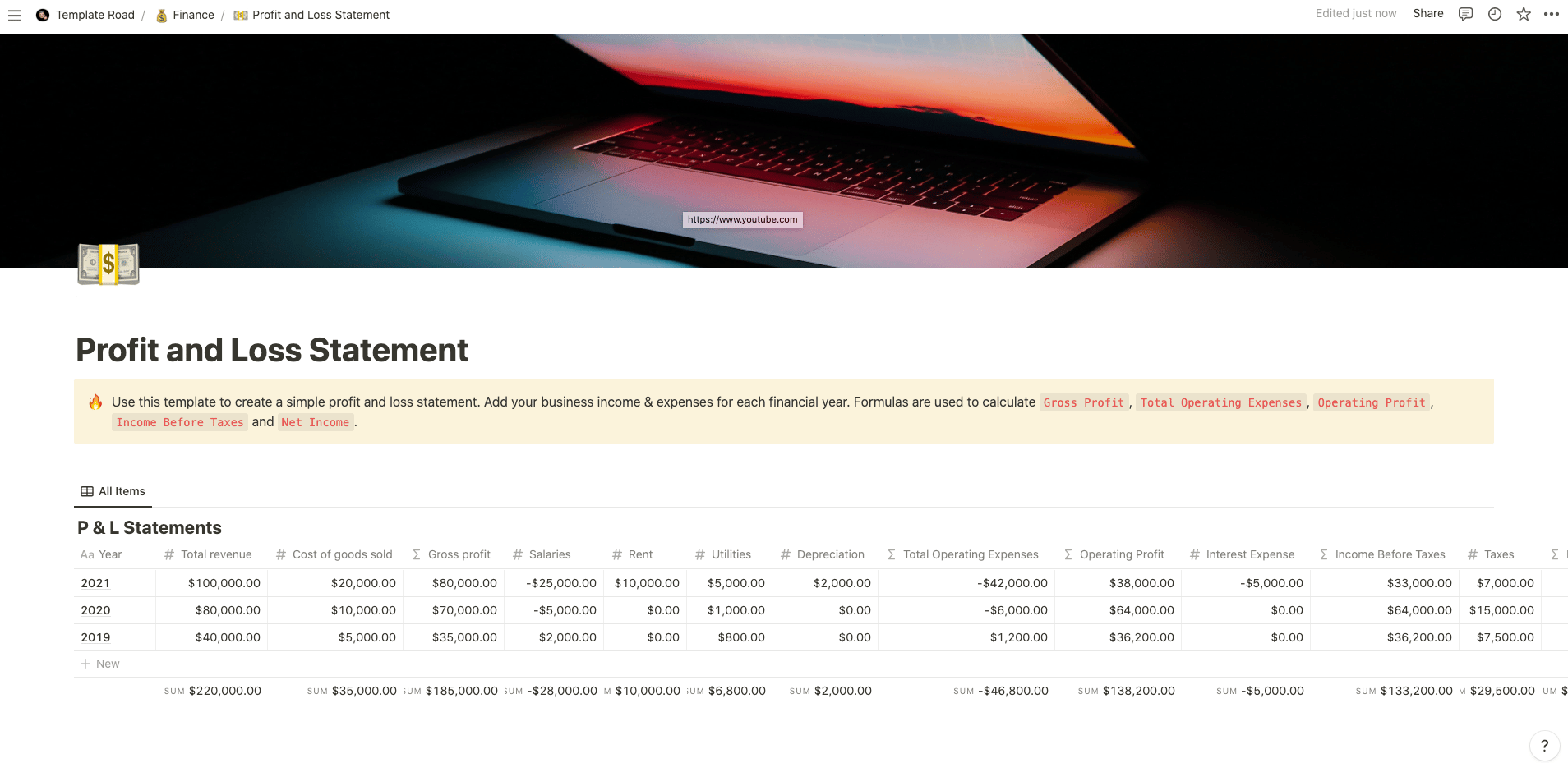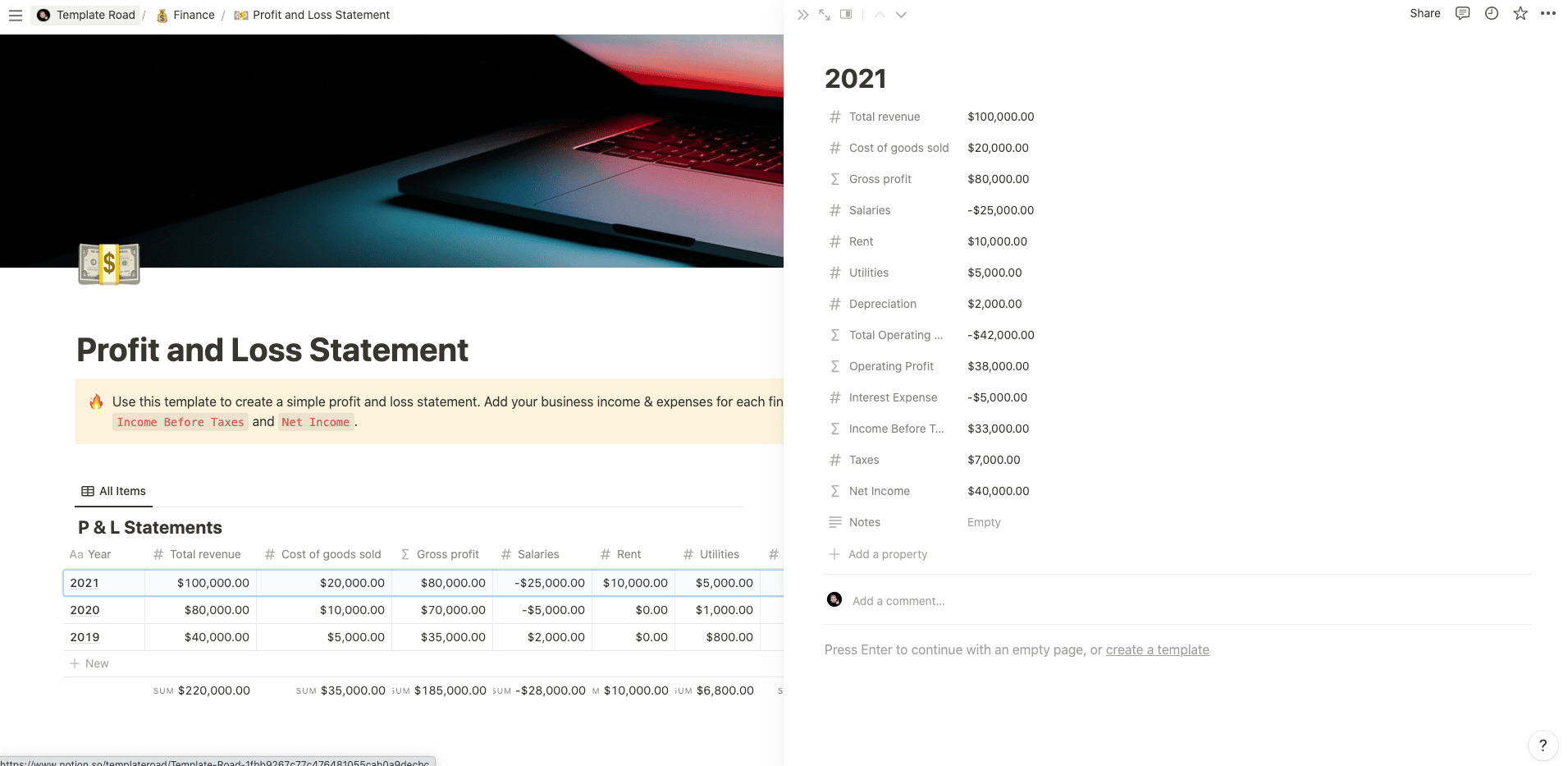Use this template to create a simple profit and loss statement in Notion.
Buy on
Contents
Notion – Profit and Loss Statement Template
Use this template to create a simple profit and loss statement in Notion. Add your business income & expenses for each financial year. Formulas are used to calculate Gross Profit, Total Operating Expenses, Operating Profit, Income Before Taxes and Net Income.
——————————————-
What you need before purchase
- Basic knowledge of how to use Notion
- Paid Notion account if you want to add lots of content to your template / Notion account (sign up here). Not much content? You’re able to use their free account.
After purchase, you’ll be able to view the template immediately. The template can be added to your Notion account by:
- Click on the template download link in Gumroad
- When viewing the Notion template, click on the “Duplicate” link in the top-right of your screen
- The template will now be available in your own Notion account
What is a profit and loss statement?
A Profit & Loss Statement (P&L) is an accounting tool that helps you see how much money you make, and how much money you spend on the products or services you sell. It also shows you where your profits come from, and what expenses are related to those profits. A P&L can help you understand if your business is making enough money to cover its costs, and if it’s losing money, it will show you why.
Key components of a profit and loss statement for small businesses
- The income section: This part of the profit and loss statement lists all of the revenue your company has generated in the past year. You’ll list each type of revenue separately, including sales, fees, commissions, interest, dividends, rent, royalties, tips, etc.
- The cost of goods sold: In this section, you’ll list all of the direct costs associated with producing your product or service. These include materials, labor, utilities, insurance, depreciation, advertising, and more.
- The operating expense section: Here, you’ll list all indirect costs associated with running your business. Indirect costs aren’t as easy to track as direct costs, but they’re just as important. They include things like employee salaries, supplies, repairs and maintenance, marketing, office space, travel, and other miscellaneous items.
- The net profit/loss: Finally, here’s where you calculate your net profit or loss. Net profit is calculated by subtracting total operating expenses from total revenue. If you have any leftover cash at the end of the year, you’ll add that amount to your net profit figure.
Balance sheet vs. profit and loss statement
While both a balance sheet and a profit and loss statement provide information about your financial situation, there are some key differences between them. The most obvious difference is that a balance sheet provides a snapshot of your assets, liabilities, equity, and overall financial health at one point in time. A profit and loss statement, however, gives you a detailed look at your finances over multiple periods of time. The second major difference is that a balance sheet only includes your current assets, liabilities, and equity. A profit and loss statement takes into account not only your current assets, liabilities and equity but also your long-term assets, such as inventory and equipment. Finally, while a balance sheet shows you exactly how much money you owe, a profit and loss statement shows you how much money you made or lost during the period covered by the report.
How to read a profit and loss statement
When reading a profit and loss statement, keep these points in mind:
- Revenue: This number represents the total amount of money your business brought in during the period covered by your profit and loss statement.
- Cost of Goods Sold: This number represents the direct costs associated with selling your product or providing your service. For example, if you bought $100 worth of raw materials to produce 100 widgets, then the cost of goods sold would be $100.
- Operating Expenses: This number represents the indirect costs associated with running the business. Things like employee salaries, advertising, and office supplies are included in this category.
- Gross Profit: This number represents the gross profit on sales. It’s calculated by multiplying the revenue by 1 plus the percentage of fixed overhead (things like rent, utilities, etc.) charged to each sale.
- Net Profit: This number represents your net profit after deducting all of your operating expenses from your revenue.
How often are profit and loss statements calculated?
Profit and loss statements are typically prepared monthly, quarterly, or annually. Quarterly reports give you an idea of whether your business is profitable or losing money over a longer period of time. Monthly reports help you see if your business is making a profit or losing money on a daily basis. Annual reports can show you trends in your company’s performance over several years.















